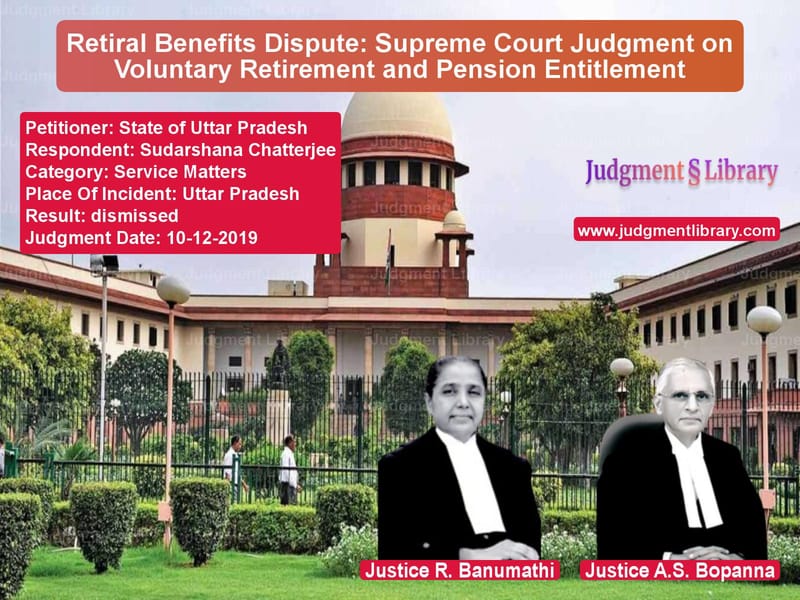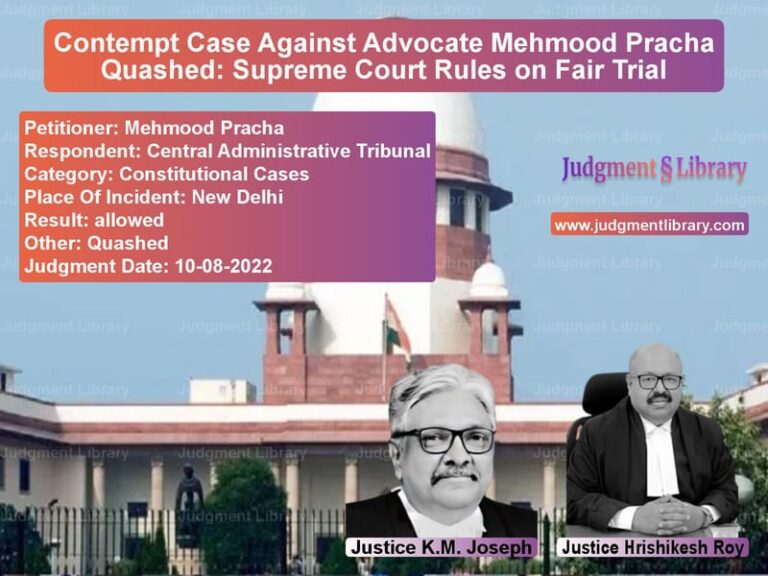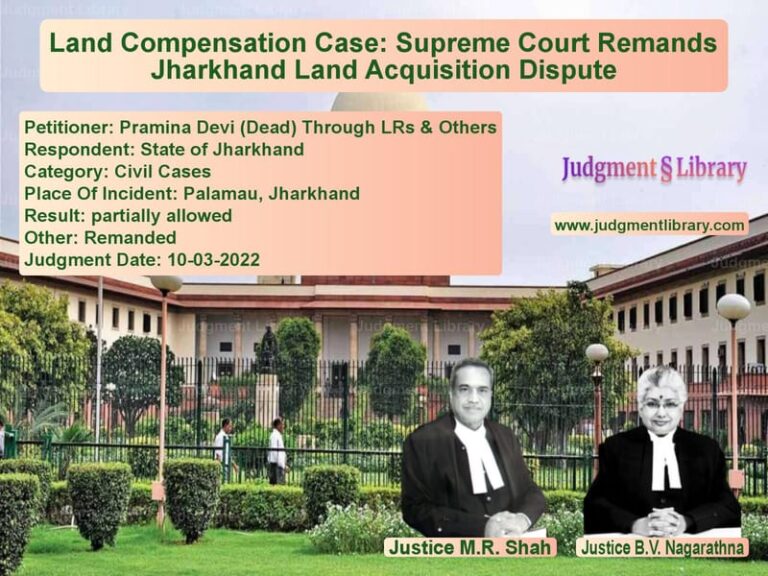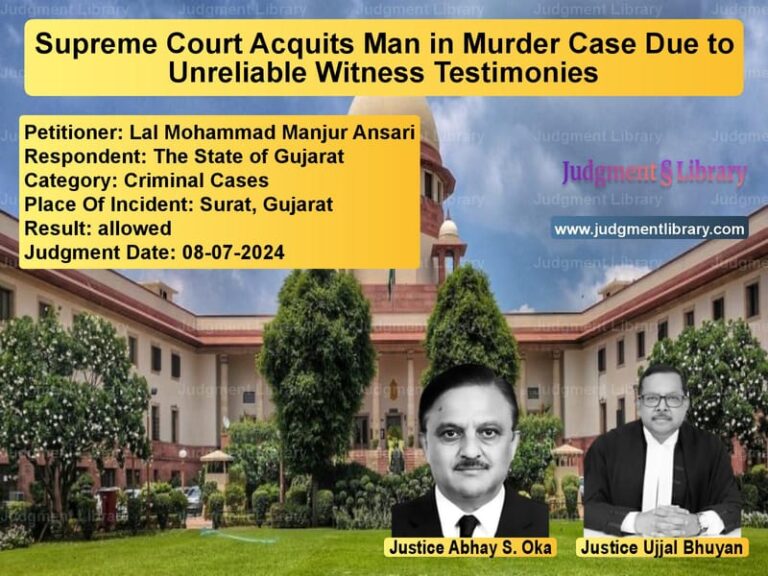Retiral Benefits Dispute: Supreme Court Judgment on Voluntary Retirement and Pension Entitlement
The case of State of Uttar Pradesh vs. Sudarshana Chatterjee deals with the issue of an employee’s entitlement to retiral benefits after voluntary retirement, despite the employee having worked with another state government without approval. The respondent, Sudarshana Chatterjee, sought the payment of her pension, gratuity, and leave encashment after retirement, while the appellants, the State of Uttar Pradesh, denied her benefits due to her unauthorized employment in another state. The case hinges on the validity of her voluntary retirement and whether she was entitled to the benefits from her previous employer, the State of Uttar Pradesh.
Background of the Case
Sudarshana Chatterjee was appointed as a Lecturer in Anesthesia at Motilal Nehru Medical College, Allahabad, by the State of Uttar Pradesh in 1982. In 2003, she sought a no-objection certificate (NOC) from the state government to apply for the post of Associate Professor in Chhattisgarh Institute of Medical Sciences (CIMS), Bilaspur. She received the NOC and joined CIMS in June 2004. However, her leave application was not approved, and she continued working at CIMS while still officially employed by the State of Uttar Pradesh. Her voluntary retirement was sought in 2005, but the appellants rejected her application due to her unauthorized service in Chhattisgarh.
In 2012, after retiring from CIMS, Sudarshana Chatterjee sought payment of her retiral benefits, which the appellants rejected, citing her failure to obtain prior approval for working in another state. The appellants’ stance was that she had abandoned her services with the State of Uttar Pradesh and therefore was not entitled to her pension or other benefits.
Chatterjee filed a writ petition before the Allahabad High Court, challenging the denial of her retirement benefits. The High Court quashed the appellants’ decision, finding that the respondent had submitted several applications seeking leave and voluntary retirement, which were ignored by the authorities. The High Court ruled that she was entitled to her pension and other retiral benefits.
Legal Issues Addressed
The case raised several significant legal questions, including:
- Whether the respondent was entitled to retiral benefits despite not receiving approval for working in another state.
- Whether the respondent’s actions in seeking voluntary retirement and working at CIMS were lawful and valid under the applicable rules.
- Whether the High Court was correct in granting the respondent her retirement benefits despite the procedural non-compliance on her part.
- Whether the appellants’ refusal to grant the respondent her retiral benefits was lawful given the facts of the case.
Arguments by the Petitioner (State of Uttar Pradesh)
The appellants, represented by Ms. Aishwarya Bhati, made the following arguments:
- The respondent left the service without proper leave approval and joined CIMS, thus abandoning her duties with the State of Uttar Pradesh. This abandonment of service disqualified her from receiving retirement benefits.
- There was no provision in the applicable rules that allowed for ex-post facto approval of leave or the grant of benefits based on unauthorized employment in another state.
- The respondent’s actions were in direct violation of the rules that govern state employees, specifically the rules requiring NOC for employment with another state and approval for leave.
- The High Court erred in holding that the respondent was entitled to her pension and other benefits despite the breach of procedures and the lack of proper approval for her leave and service in Chhattisgarh.
Arguments by the Respondent (Sudarshana Chatterjee)
The respondent, represented by Mr. Kuriakose Varghese, presented the following arguments:
- The respondent’s decision to join CIMS was based on the absence of a timely response from the State of Uttar Pradesh to her leave and NOC applications. She had no alternative but to join CIMS for her professional advancement.
- The respondent had submitted multiple leave applications, but they were not acted upon by the appellants. The delay in responding to her leave applications prevented her from adhering to the formal procedures.
- After her voluntary retirement, the respondent promptly applied for her retiral benefits, but the appellants unjustifiably denied her the benefits due to procedural lapses, which she had no control over.
- Even if her service at CIMS was unauthorized, the appellants were estopped from denying her the benefits due to the long period of service she had completed with the State of Uttar Pradesh.
Supreme Court’s Observations and Ruling
The Supreme Court bench, comprising Justice R. Banumathi and Justice A.S. Bopanna, made the following key observations:
1. The Legality of Voluntary Retirement
The Court found that the respondent’s voluntary retirement was valid and had been filed in good faith. The Court observed:
“While the respondent’s employment in CIMS was not authorized by the appellants, her application for voluntary retirement was submitted in accordance with the rules. The refusal to grant her retirement benefits based on technical procedural violations is not justified.”
The Court ruled that the respondent’s voluntary retirement was valid, as it was filed under the applicable provisions and not hindered by any legal requirement preventing her from doing so.
2. Failure of the State to Respond
The Court highlighted the appellants’ failure to act on the respondent’s repeated requests for leave and voluntary retirement:
“The delay in processing the respondent’s applications for leave and retirement was caused by the appellants. The respondent’s efforts to comply with the formal procedures were hampered by the lack of a timely response from the appellants, thus preventing her from formally leaving her post and pursuing her career at CIMS.”
The Court found that the appellants’ failure to act on the leave applications was a significant factor that led to the respondent’s unauthorized employment in CIMS.
3. Procedural Compliance and Discretion of the Court
The Court reiterated the importance of procedural compliance but also exercised its discretion to grant relief to the respondent:
“While procedural compliance is essential, it is also critical to consider the practical realities faced by the employee. The respondent’s actions, while not entirely in compliance with the rules, were a result of the appellants’ inaction. In such cases, strict adherence to procedure should not override the interests of justice.”
The Court ruled that the respondent was entitled to her retirement benefits despite the procedural shortcomings, as the appellants had not given the respondent a fair opportunity to complete the necessary formalities.
4. The Role of the High Court in Directing Relief
The Court found that the High Court had appropriately directed the appellants to review the respondent’s case in accordance with the law:
“The High Court rightly directed the appellants to reconsider the respondent’s case, taking into account the circumstances that led to the procedural irregularities. However, the direction for personal appearance of the Principal Secretary was unwarranted, as the issue could have been resolved administratively.”
The Court emphasized that the personal appearance of officers should not be required in cases that can be settled through administrative processes.
Final Judgment
The Supreme Court ruled as follows:
“The appeal filed by the State of Uttar Pradesh is dismissed. The respondent is entitled to her pension, gratuity, and leave encashment. The appellants are directed to make the payment of the retirement benefits to the respondent within a period of three months, along with arrears, and any applicable interest.”
The Court upheld the High Court’s decision but corrected the procedural error regarding the personal appearance of the Principal Secretary.
Implications of the Judgment
This ruling has significant implications for administrative processes related to retirement and the entitlement to benefits:
- Voluntary Retirement: The Court affirmed that voluntary retirement should not be denied based on procedural errors that were not the fault of the employee.
- State Responsibility: The judgment underscores the responsibility of state authorities to act promptly on leave and retirement applications.
- Public Servants’ Rights: The ruling sets a precedent for cases where employees are denied benefits due to inaction or delays on the part of the administration.
Conclusion
The Supreme Court’s ruling in The State of Uttar Pradesh vs. Sudarshana Chatterjee highlights the need for administrative efficiency in dealing with public servants’ retirement and benefits. The decision ensures that employees who have served their duties with due diligence are not denied their rightful entitlements due to procedural delays and inaction from the authorities.
Petitioner Name: State of Uttar Pradesh.Respondent Name: Sudarshana Chatterjee.Judgment By: Justice R. Banumathi, Justice A.S. Bopanna.Place Of Incident: Uttar Pradesh.Judgment Date: 10-12-2019.
Don’t miss out on the full details! Download the complete judgment in PDF format below and gain valuable insights instantly!
Download Judgment: State of Uttar Prade vs Sudarshana Chatterje Supreme Court of India Judgment Dated 10-12-2019.pdf
Direct Downlaod Judgment: Direct downlaod this Judgment
See all petitions in Employment Disputes
See all petitions in Promotion Cases
See all petitions in Workplace Harassment
See all petitions in Judgment by R. Banumathi
See all petitions in Judgment by A. S. Bopanna
See all petitions in dismissed
See all petitions in supreme court of India judgments December 2019
See all petitions in 2019 judgments
See all posts in Service Matters Category
See all allowed petitions in Service Matters Category
See all Dismissed petitions in Service Matters Category
See all partially allowed petitions in Service Matters Category







